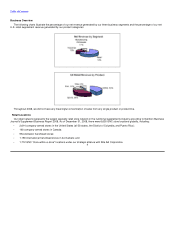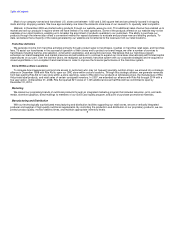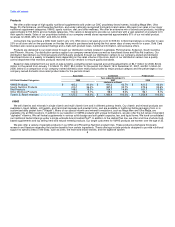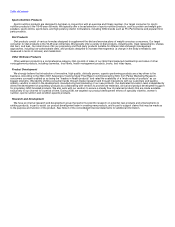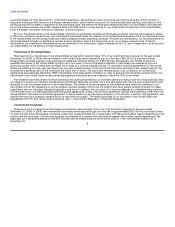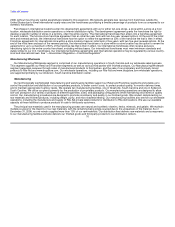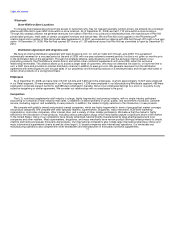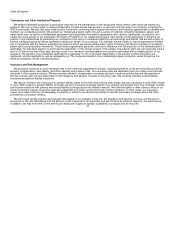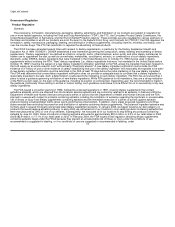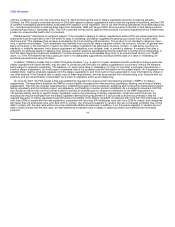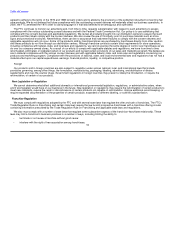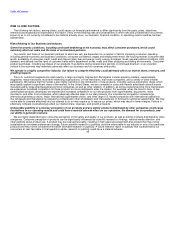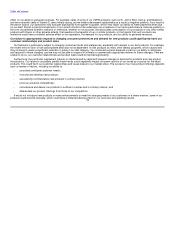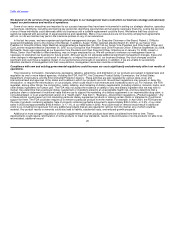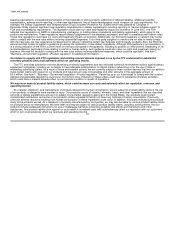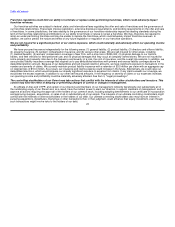GNC 2009 Annual Report Download - page 19
Download and view the complete annual report
Please find page 19 of the 2009 GNC annual report below. You can navigate through the pages in the report by either clicking on the pages listed below, or by using the keyword search tool below to find specific information within the annual report.
Table of Contents
ordinary conditions of use. The rule took effect April 12, 2004 and banned the sale of dietary supplement products containing ephedra.
Similarly, the FDA issued a consumer advisory in 2002 with respect to dietary supplements that contain the ingredient Kava Kava, and the FDA
is currently investigating adverse effects associated with ingestion of this ingredient. One of our then existing subsidiaries, Nutra Manufacturing,
Inc., manufactured products containing Kava Kava from December 1995 until August 2002. All stores were instructed to stop selling products
containing Kava Kava in December 2002. The FDA could take similar actions against other products or product ingredients which it determines
present an unreasonable health risk to consumers.
DSHEA permits "statements of nutritional support" to be included in labeling for dietary supplements without FDA pre-market approval. Such
statements must be submitted to the FDA within 30 days of marketing, and dietary supplements bearing such claims must include a label
disclosure that "This statement has not been evaluated by the Food and Drug Administration. This product is not intended to diagnose, treat,
cure, or prevent any disease." Such statements may describe how a particular dietary ingredient affects the structure, function, or general well-
being of the body, or the mechanism of action by which a dietary ingredient may affect body structure, function, or well-being, but may not
expressly or implicitly represent that a dietary supplement will diagnose, cure, mitigate, treat, or prevent a disease. A company that uses a
statement of nutritional support in labeling must possess scientific evidence substantiating that the statement is truthful and not misleading. If
the FDA determines that a particular statement of nutritional support is an unacceptable drug claim or an unauthorized version of a "health
claim," or, if the FDA determines that a particular claim is not adequately supported by existing scientific data or is false or misleading, we
would be prevented from using the claim.
In addition, DSHEA provides that so-called "third-party literature," e.g., a reprint of a peer-reviewed scientific publication linking a particular
dietary ingredient with health benefits, may be used "in connection with the sale of a dietary supplement to consumers" without the literature
being subject to regulation as labeling. The literature: (1) must not be false or misleading; (2) may not "promote" a particular manufacturer or
brand of dietary supplement; (3) must present a balanced view of the available scientific information on the subject matter; (4) if displayed in an
establishment, must be physically separate from the dietary supplements; and (5) should not have appended to it any information by sticker or
any other method. If the literature fails to satisfy each of these requirements, we may be prevented from disseminating such literature with our
products, and any dissemination could subject our product to regulatory action as an illegal drug.
On June 22, 2007, the FDA issued a final rule establishing regulations to require good manufacturing practices ("GMPs") for dietary
supplements. The regulations establish the GMPs to ensure quality throughout the manufacturing, packaging, labeling, and storing of dietary
supplements. The final rule includes requirements for establishing quality control procedures, designing and constructing manufacturing plants,
testing ingredients and the finished product, recordkeeping, and handling consumer product complaints. As a companion document, the FDA
also issued an interim final rule that outlines a petition process for manufacturers to request an exemption to the GMP requirement for
100 percent identity testing of specific dietary ingredients used in the processing of dietary supplements. Under the interim final rule, the
manufacturer may be exempted from the dietary ingredient identity testing requirement if it can provide sufficient documentation that the
reduced frequency of testing requested would still ensure the identity of the dietary ingredient. Companies with more than 500 employees had
until June 2008 to comply with the new regulations, companies with less than 500 employees have until June 2009 to comply, and companies
with fewer than 20 employees have until June 2010 to comply. Our third-party suppliers or vendors who are not already compliant may not be
able to comply with the new rules without incurring substantial additional expenses. In addition, if our third-party suppliers or vendors are not
able to timely comply with the new rules, we may experience increased costs or delays in obtaining certain raw materials and third-party
products. 14


